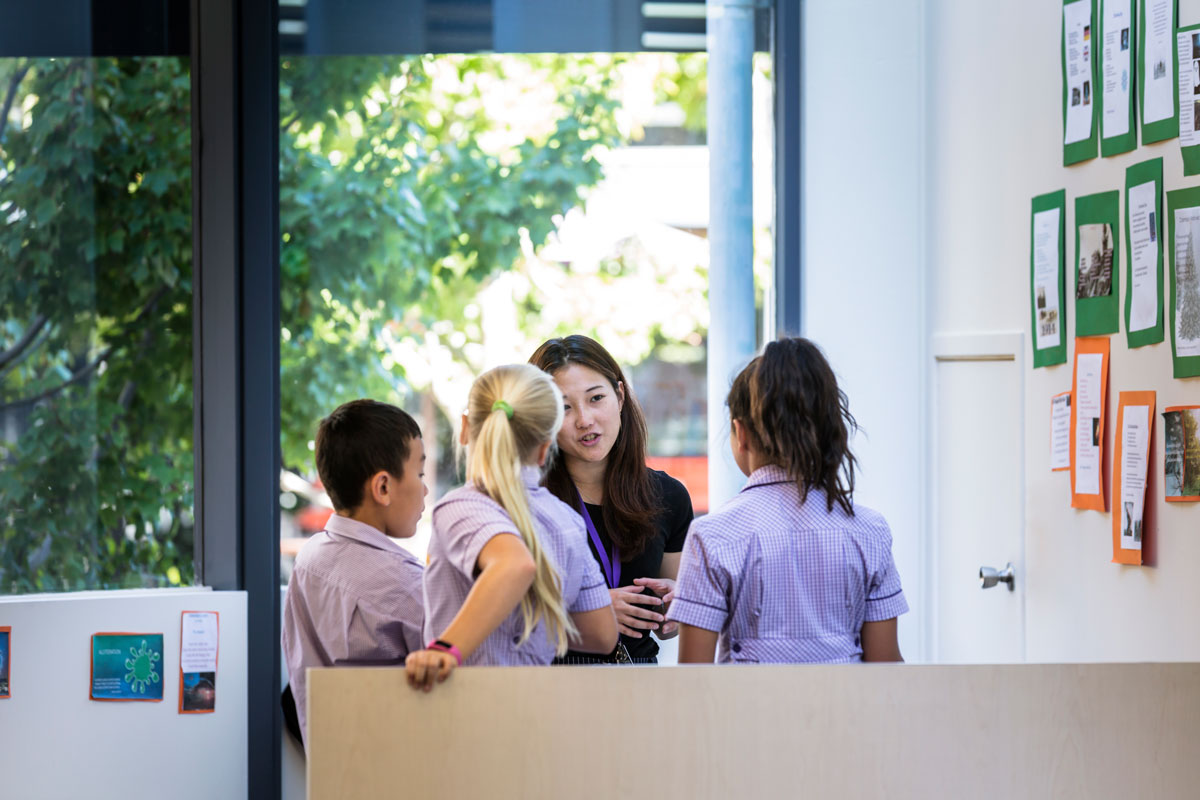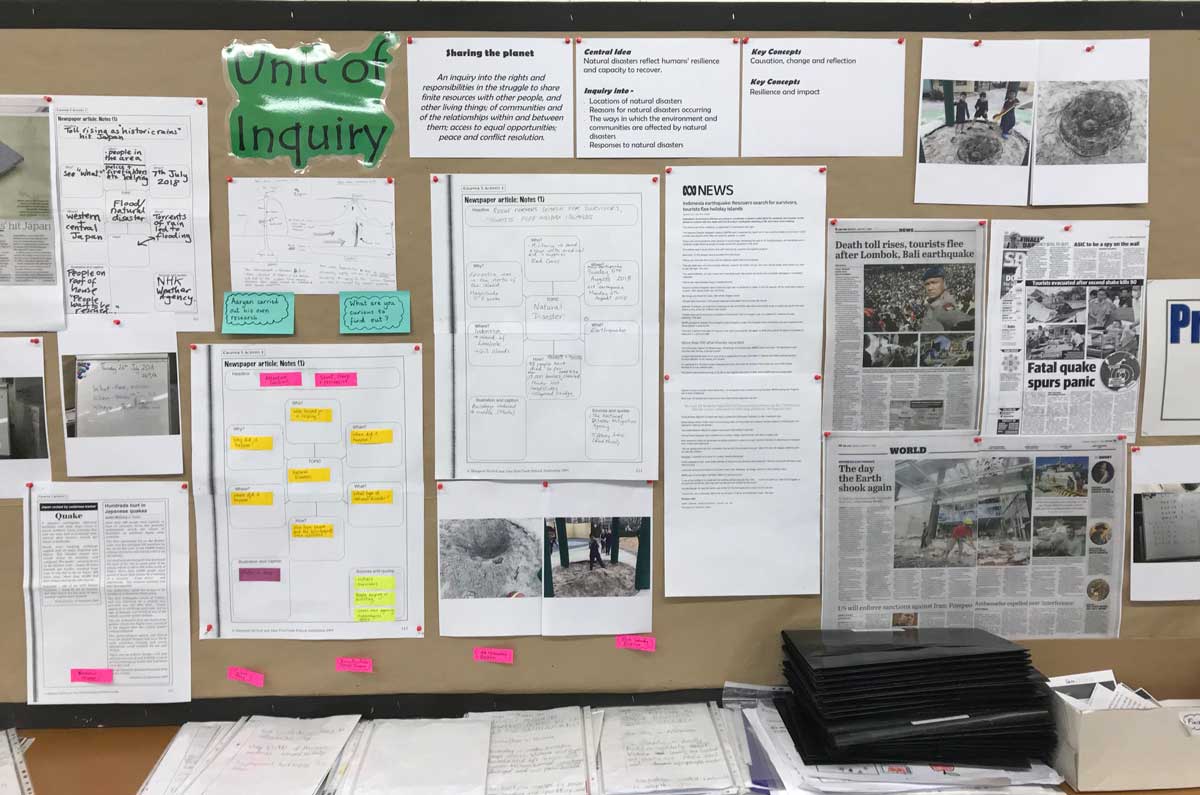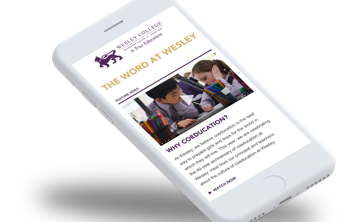
One of the long-term goals in supporting students as they extend their writing capabilities is to develop their writing independence. Ben Reeves spoke with Katie Orton, Pippa Wilson, Vivienne Owers and Pene Walsh to understand how they develop students’ writing through an innovative three-pronged approach that explicitly teaches student independence, frees up one-on-one time for feedback and uses a common language to scaffold learning.
Ben Reeves is a College Teaching Practice Leader at Wesley’s St Kilda Road Campus. Katie Orton is Head of Learning, Primary Years Program (PYP) at St Kilda Road. Pippa Wilson, Vivienne Owers and Pene Walsh are PYP teachers at St Kilda Road.
Ben: What prompted your focus on student writing?
Katie:
When we teach writing with our classes, it can happen that we reach a stage where several children need our support at the same time, often one-on-one or in small groups, in order for them to continue on with the writing process. In our discussions about this, our consensus was that it’s difficult to support each student when we reach that point, and so we began to investigate solutions and share our ideas.
One idea I was investigating is a writing framework called 6 + 1 traits of writing. Our collaborative work led us to ask whether this framework would be effective in enabling us to support students of all ability to experience writing independence. Our focus in ‘road testing’ the 6 + 1 traits of writing was on measuring its effectiveness.
Ben: Could you tell us more about the 6 + 1 approach?
Pippa:
It’s a whole-school focus where everyone uses the same common language as we teach writing. There are the six traits of writing: ideas, organisation, voice, word choice, sentence fluency and conventions – plus presentation, hence ‘6 + 1 traits of writing.’ Each trait has a rubric, which gives teachers and students a common assessment language and descriptions of what those traits look like as a continuum of writing capability at increasing levels. This enables us to focus on particular aspects of writing. For example, we might focus on the ‘ideas’ trait. Using the rubric and continuum, we’re able to look at where the students’ writing is at, and then how we’re going to move them forward.
Ben: Where does the goal of student independence fit into this?
Vivienne:
We decided that the best way we can provide an opportunity for guided writing successfully is when the students have independence, so when they’re unsure about the next step they have the mindset and strategies to progress if we’re not able to advise at that exact moment. And we want to teach them independence because it’s a crucial attribute of successful students. As students develop as independent learners, with a clear understanding of the 6 + 1 traits of writing, we’re finding greater opportunities to use one-on-one and group conferencing approaches that complement their independent learning.
We’ve found that providing students with a clear framework to structure their writing has encouraged their independent progress as writers. But even with that in place, there still tends to be a point when they branch off in their own writing, sometimes where they ‘go out on a limb’ in a very productive way but they’re unsure about the next step, other times in a way where they might simply ‘get stuck.’ Either way, this is often the point where they need the most support, through one-on-one or group conferencing. It’s worth pointing out that group conferencing for independent learning isn’t a contradiction: we’re finding that group conferencing suits independent learners because students at a similar point in their learning progress often face the same kinds of issues at the same time, or have just faced a similar issue.
What we’ve discovered is that, often, the best way to support our students is to set up activities, maybe not specifically focussed on their writing, that they can manage on their own, such as a unit of inquiry that involves everything from auditing what they already know and can do to synthesising and applying new knowledge and skills. In this ‘non-writing’ process, many students will still get to a point where they are stuck and use ‘non-writing’ strategies to get unstuck. Essentially, we’ve found that students asking themselves, ‘If I’m not with the teacher, what am I going to do?’ enables them to transfer these strategies to the writing process.
Ben: Did you have to build these independence skills, first?
Pene:
Absolutely. We knew that independence had to be a priority. We needed to build their independence, so we could be of greater assistance when they reached the limits of their existing strategies. This is really about student agency. To build this, there are strategies you need to use to set up the groups. You need to take time to establish norms and routines so students know what to do when they say to themselves, ‘Okay, I can’t work with the teacher right now, so what will I do?’ Often, you need to teach these steps explicitly – ‘If I finish this, then I know to go on to that.’ Teaching them explicitly what effective steps they can take helps to develop not only the routines of student agency, but also the attitudes.
That’s a lot of effort at the start, but it pays off in the end! It sets you up for the year.
Ben: So, how did you set up the class to enable support through group conferencing, for example?
Katie:
In Prep we had a sentence of the week and a word of the week. Usually, our writing task might be a ‘weekend recount’ or it might be connected to the word of the week, or sentence of the week. We experimented with doing literacy rotations, like a reading task or flip chart sound-letter connections that they can do independently, with one group in the rotation in a writing session with the teacher at any one time.
It’s the writing session group we’ve been experimenting with, working with four or five children, one-on-one and group conferencing, so you can give them feedback there and then. Students need and benefit from instant feedback. This has been really helpful, to work with that smaller group; that one-on-one feedback really helps to move them forward.
Ben: How does the 6 +1 framework, and other techniques, help with students knowing ‘what to go on with’ when they’re not one-on-one or group conferencing with their teacher?
Pippa:
Because each trait has a rubric, with a common assessment language and descriptions, it gives teachers and students clear success criteria – and when that has been agreed with the class, and everyone is clear on the expectations, that’s their go to. Students can use the rubric to ask, ‘What have I included, what haven’t I?’ As a teaching team, we’re exploring the benefits of a working wall of student writing. The things that go up there are the things that have been shared with the class, such as a checklist of research steps, so if a student says, ‘Oh, I don’t know what to do next,’ I can respond, ‘Where can you go and look?’ During one-on-one conferences, we’re helping students make their own guided choices. This is encouraging independence. The rubrics helps to structure their goals and learning.

A working wall of student writing: working walls bring together exemplars, resources and checklists, so if a student says, ‘Oh, I don’t know what to do next,’ their teacher can respond, ‘Where can you go and look?’
Ben: There seems to be an important role for questioning in the development of independence?
Vivienne:
Yes, it’s important to use questions to promote independence, rather than just telling students what to do every time.
And how does having a common language help teams working together?
Vivienne:
This is something that came up in our discussions – we all discovered in our conversations that we have a very similar approach, a bit like a writing cycle. We tend to lead in by looking at particular examples of the genre that we want the students to be working in, pulling those apart, looking at the features, and through that, looking at the success criteria. The 6 + 1 traits of writing framework brought that together because the rubrics the criteria can then be broken down further, to support the different writing processes.
Most importantly, the framework enables discussion about what’s worked, what hasn’t worked and what we’d like to learn more about as well, to further develop our skills, and have more team discussions about, relevant to everybody. Again, the benefit of working with a common language, is for both teachers and students.
The framework also enables us to focus on specific aspects of the approach; for example, ‘This term, we’re focusing on fluency.’ Or, ‘Today, we’re all working on our ideas.’ Then the students know what to expect – using the rubric, with a model of a good piece of writing, with an excellent piece. That transparency and specificity takes the pressure off the ‘whole’ writing – in effect, we’re saying, ‘We’re not worried about your spelling today – we’re focusing on how you generate ideas, or on the fluency of your narrative or whatever.’ This validates students in taking risks and pushing themselves to improve, in this case, as writers.
Ben: Pulling this all together, what have you noticed in the students?
Pene:
Working in small groups with writing has given students more confidence – especially those who find it difficult to decode and struggle with spelling. It’s given them that confidence of the teacher being with them. So when we do whole-class writing activities, we’re seeing them being more independent, and having a go in their writing. I’m also able to remind them, ‘Remember what we were doing when we were sounding out words?’ The framework gives them confidence, and a positive attitude, ‘I can have a go, I can do it – it doesn’t matter if I misspell the word, but I can have a go at fluency.’
So much about student learning goes back to student agency – the development of a positive attitude, a growth mindset and having the independence and confidence to have a go, because we’ve made the writing process more transparent for our students.
Ben Reeves is a College Teaching Practice Leader at Wesley’s St Kilda Road Campus. Katie Orton is Head of Learning, Primary Years Program (PYP) at St Kilda Road. Pippa Wilson, Vivienne Owers and Pene Walsh are PYP teachers at St Kilda Road.
